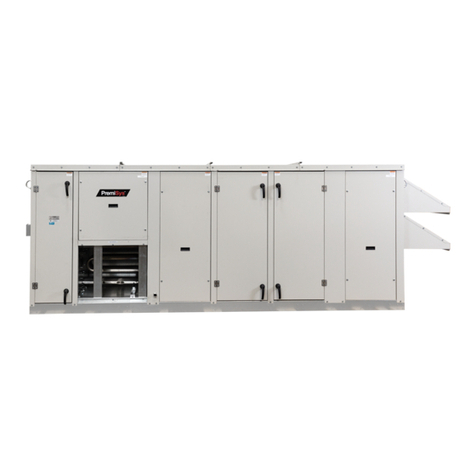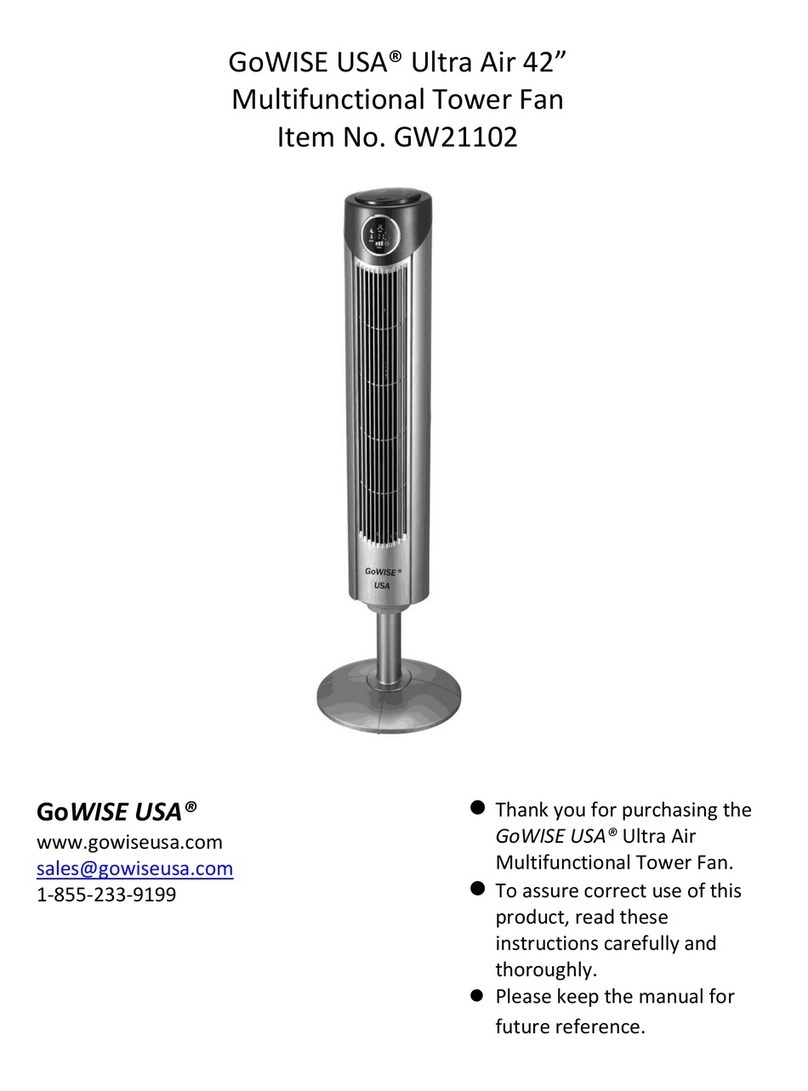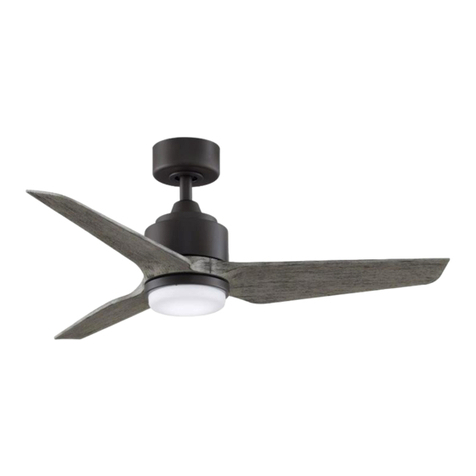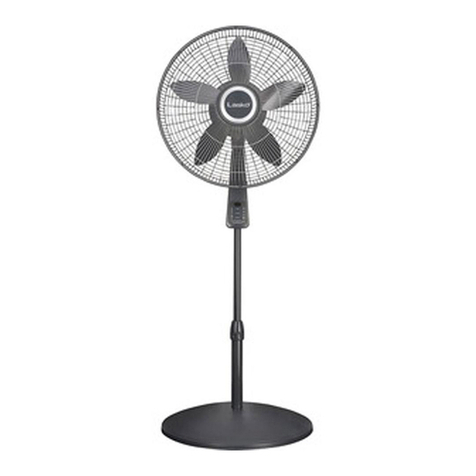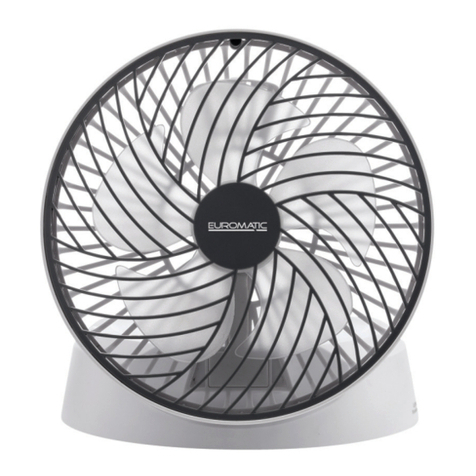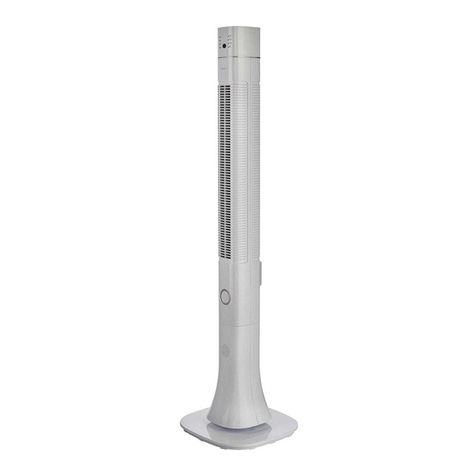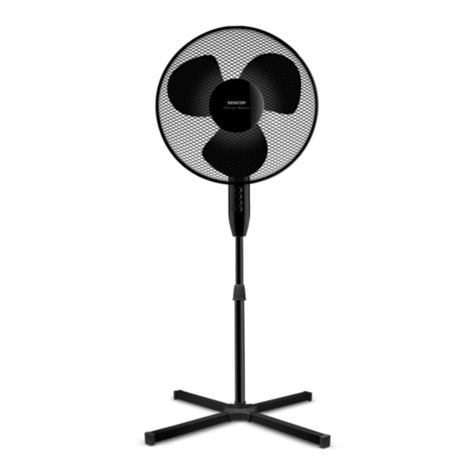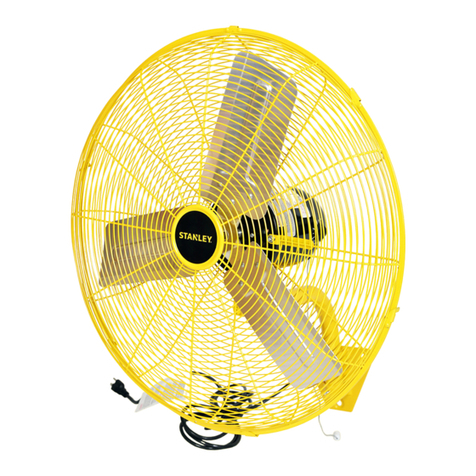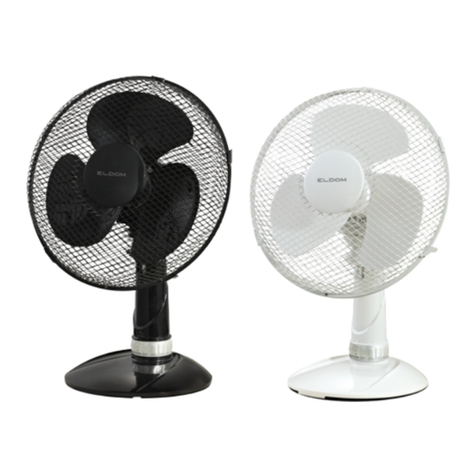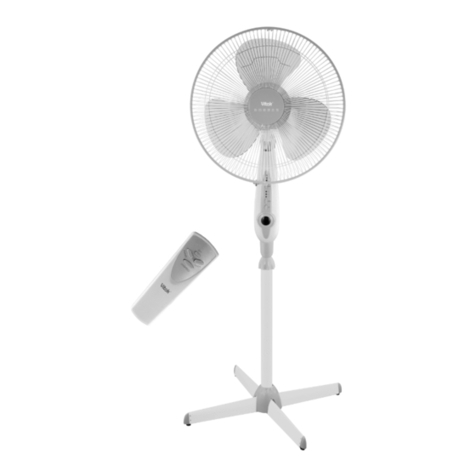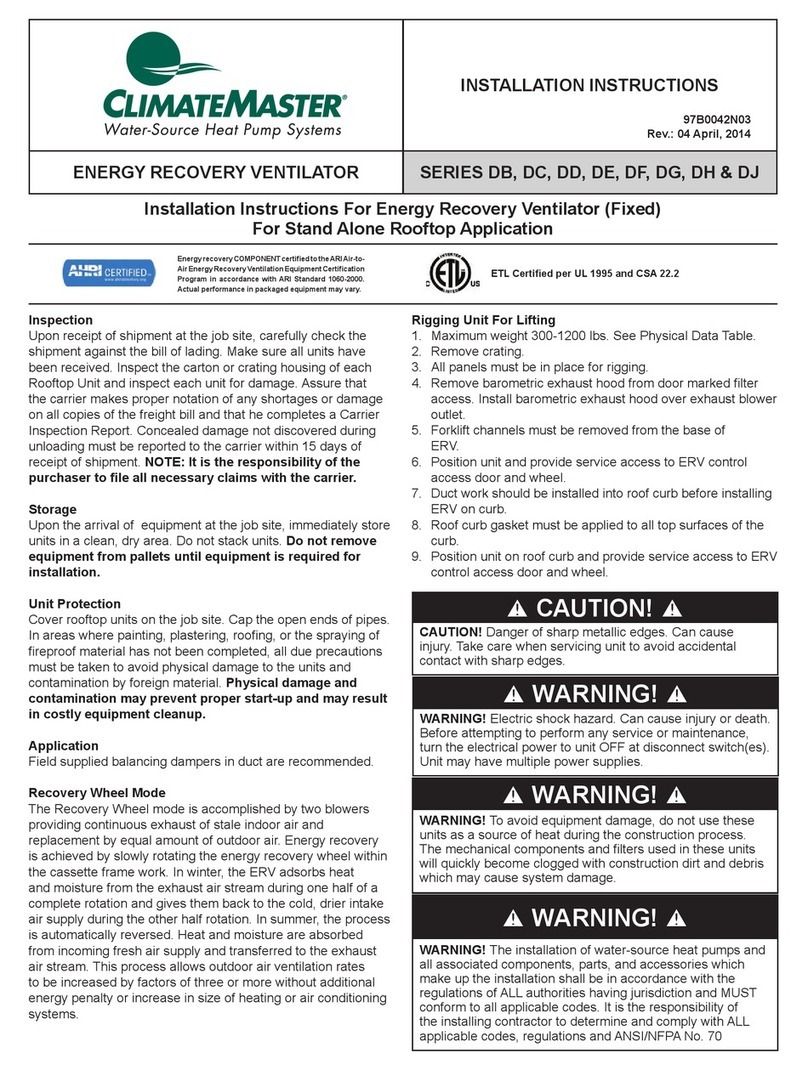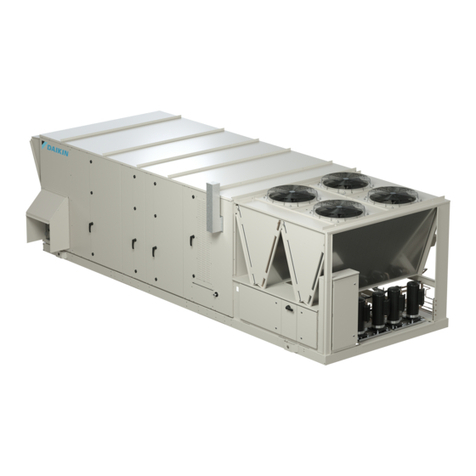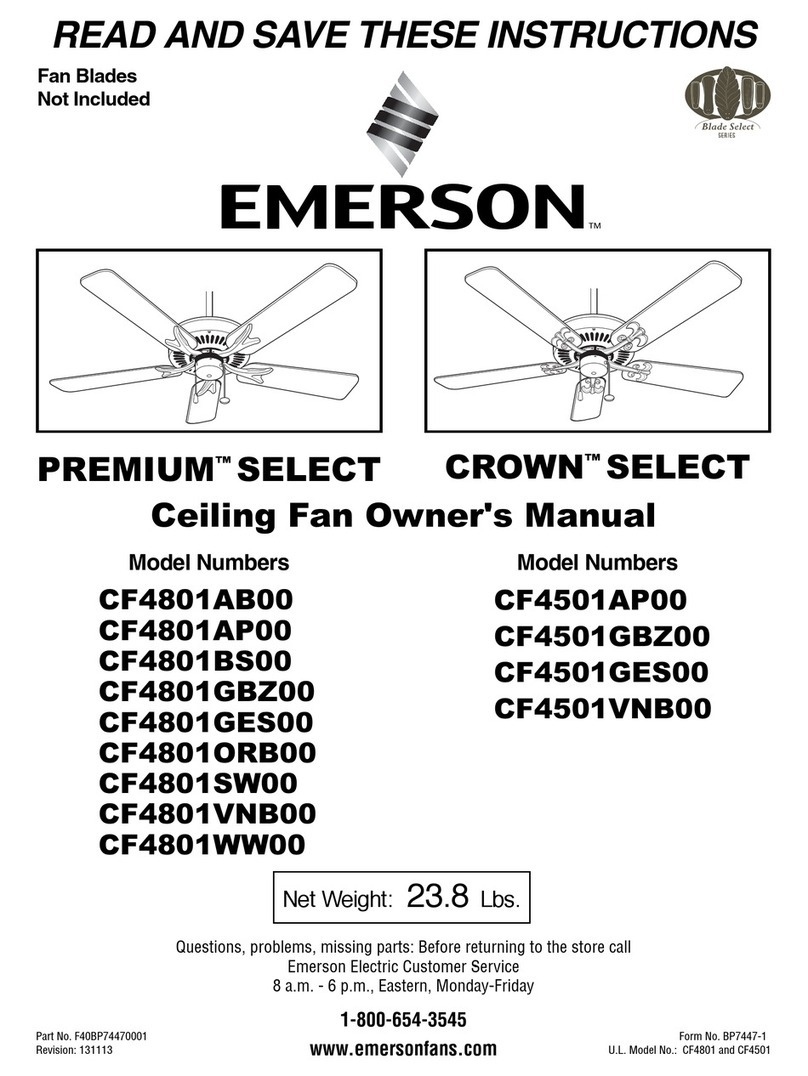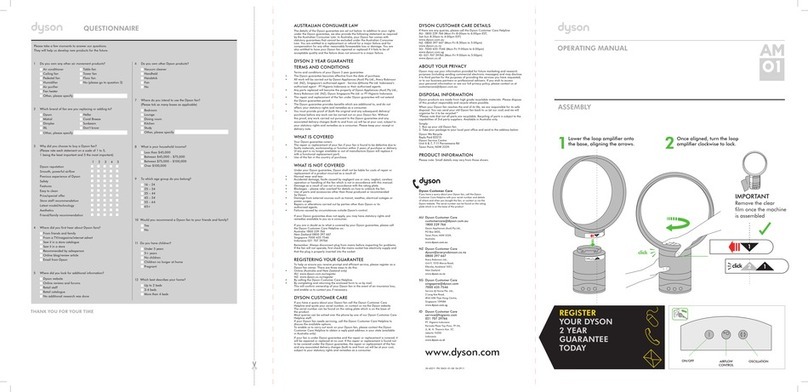Premisys MP Series User manual

Installation, Operation and Maintenance Manual
Please read and save these instructions for future reference. Read carefully before attempting to assemble, install,
operate or maintain the product described. Protect yourself and others by observing all safety information. Failure
to comply with instructions could result in personal injury and/or property damage!
1
Packaged and Split Rooftop Ventilator
PremiSys
General Safety Information
WARNING
The roof lining contains high voltage wiring. To prevent
electrocution, do not puncture the interior or exterior
panels of the roof.
DANGER
• Always disconnect power before working on or near
this equipment. Lock and tag the disconnect switch or
breaker to prevent accidental power up.
• If this unit is equipped with optional gas accessories,
turn off gas supply whenever power is disconnected.
CAUTION
This unit is equipped with a compressed refrigerant
system. If a leak in the system should occur,
immediately evacuate the area. An EPA Certified
Technician must be engaged to make repairs or
corrections. Refrigerant leaks may also cause bodily
harm.
CAUTION
When servicing the unit, the internal components may
be hot enough to cause pain or injury. Allow time for
cooling before servicing.
Only qualied personnel should install and maintain this
system. Personnel should have a clear understanding of
these instructions and should be aware of general safety
precautions. Improper installation can result in electric
shock, possible injury due to coming in contact with
moving parts, as well as other potential hazards. Other
considerations may be required if high winds or seismic
activity are present. If more information is needed,
contact a licensed professional engineer before moving
forward.
1. Follow all local electrical and safety codes, as well as
the National Electrical Code (NEC), the National Fire
Protection Agency (NFPA), where applicable. Follow
the Canadian Electrical Code (CEC) in Canada.
2. All moving parts must be free to rotate without striking
or rubbing any stationary objects.
3. Unit must be securely and adequately grounded.
4. Do not spin wheel faster than maximum cataloged
fan RPM. Adjustments to fan speed signicantly
affect motor load. If the fan RPM is changed, the
motor current should be checked to make sure it is
not exceeding the motor nameplate amps.
5. Verify that the power source is compatible with the
equipment.
6. Never open access doors to the unit while it is
running.
Models MP/MPE (Packaged DX) Model MPF (Split DX)
Document 479650
Models MP, MPE and MPF
Packaged and Split Rooftop Ventilator
© 2017 Mitsubishi Electric US, Inc.
Premi
Sys

2Packaged and Split Rooftop Ventilator
Table of Contents
General Safety Information ....................1
Receiving, Handling, Storage...................3
Product Overview
Cooling ....................................4
Heating....................................4
Airflow Arrangement..........................4
Safety Listing ...............................4
Supplemental IOM Manuals....................4
Models and Capacities........................4
Subassemblies
Blower ....................................5
Coils ......................................5
Compressors ...............................5
Dampers...................................5
Electric Heater ..............................5
Filters .....................................5
Indirect Gas-Fired Furnace ....................5
Packaged DX System ........................5
Split DX System .............................5
Installation
Packaged DX Weights, Dimensions, Clearance ....6
Split DX Weights, Dimensions, Clearance.........7
Additional Clearances for Packaged DX ..........8
Handling Concerns for Units with Package DX .....8
Lifting .....................................8
Installation Site Requirements ..................8
Roof Curb Mounting..........................9
Ductwork Configurations ......................9
Rail Mounting and Layout .....................9
Electrical Information
Determine the Size of Main Power Lines ........10
Determine the Size of Electric Heater Wiring .....10
Opening(s) for the Electrical Connections ........10
Connect the Power Supplies ..................10
Wire the Optional Convenience Outlet ..........10
Connect Field-Wired Low Voltage Components ...10
Field-Provided Disconnect ....................10
Electrical/Gas Supply Entry Locations ...........11
Alternate Supply Entry Locations...............11
Indirect-Gas Piping Installation
Optional Gas Piping .........................11
Water Coil Piping Installation
Optional Coil Piping .........................12
Water Coils................................12
Condensate Drain Trap ......................12
Split DX Piping Installation
R410 PIping Material ........................13
Piping Design ...........................13-14
Refrigerant Charge Calculation ................15
Piping Connections .........................16
Control Center Components
Main Control Center.........................17
Optional Indirect Gas-Fired Furnace ............17
Component Operation
Phase Monitor .............................17
Variable Frequency Drive.....................17
Supply Fan VFD Sequence ...................17
Exhaust Fan Only Power .....................18
Airflow Monitoring ..........................18
Factory-Installed Refrigeration Systems
Packaged DX ..............................19
Split DX ..................................20
Electrical Parts Specification ................21
Component Operation......................21
Start-Up – Unit
Model and Serial Number ....................22
Pre-Start-Up Checklist .......................23
Special Tools Required ......................23
Start-Up Procedure .........................23
Voltage Imbalance ..........................23
Start-Up Checklist ..........................23
Start-Up – Components
Fan ......................................25
Supply Fan (Plenum Type) ...................25
Fan Wheel Rotation Direction .................25
Supply/Exhaust Fan .........................25
Vibration ..................................25
Discharge Air Temperature Sensor .............25
Airflow Monitor .............................26
Optional Energy Wheel
Start-Up ..................................27
Drive Belt .................................27
Adjust the Air Seals .........................27
Sequence of Operation ......................27
Maintenance...............................28
Inspection.................................28
Wheel Disassembly .........................28
Cleaning ..................................28
Reassembly ...............................28
Energy Recovery Wheel Belt ..................28
Energy Recovery Wheel Bearings ..............28
Energy Recovery Wheel - Troubleshooting .......29
Troubleshooting
Alarms
Microprocessor Controller ..................29
Phase Monitor............................29
Variable Frequency Drive ...................29
Optional FX05 Furnace Controller ............29
Optional Digital Scroll Compressor Controller ...29
Unit......................................30
Refrigeration Circuit
Packaged ............................31-34
Split .................................35-37
Routine Maintenance
Monthly...................................38
Semiannually ..............................38
Annually ..................................38
Units with Packaged DX, Semiannually..........38
Maintenance Procedures
Lubrication ................................39
Dampers..................................39
Gas Furnace ..............................39
Fan Motors ................................39
Fan Wheel and Fasteners ....................39
Internal Filter Maintenance ...................39
External Filter Maintenance ...................39
Coil Maintenance ...........................39
Maintenance Log ..................... Backcover
© 2017 Mitsubishi Electric US, Inc.
PremiSys

3
Packaged and Split Rooftop Ventilator
Receiving
This product may have been subject to road salt during
transit. If so, immediately wash off all visible white
reside from all exterior surfaces. Upon receiving the
product, check to ensure all line items are accounted
for by referencing the delivery receipt or packing list.
Inspect each crate or carton for shipping damage before
accepting delivery. Alert the carrier if any damage is
detected, do not refuse shipment. The customer shall
make notation of damage (or shortage of items) on the
delivery receipt and all copies of the bill of lading should
be countersigned by the delivering carrier. If damaged,
immediately contact your manufacturer’s representative.
Any physical damage to the unit after acceptance is not
the responsibility of the manufacturer.
Handling
Units are to be rigged and moved by the lifting brackets
provided or by the skid when a forklift is used. Location
of brackets varies by model and size. Handle in such
a manner as to keep from scratching or chipping the
coating. Damaged nish may reduce ability of unit to
resist corrosion.
Unpacking
Verify that all required parts and the correct quantity
of each item have been received. If any items are
missing, report shortages to your local representative to
arrange for obtaining missing parts. Sometimes it is not
possible that all items for the unit be shipped together
due to availability of transportation and truck space.
Conrmation of shipment(s) must be limited to only items
on the bill of lading.
Storage
Units are protected against damage during shipment. If
the unit cannot be installed and operated immediately,
precautions need to be taken to prevent deterioration of
the unit during storage. The user assumes responsibility
of the unit and accessories while in storage. The
manufacturer will not be responsible for damage during
storage. These suggestions are provided solely as a
convenience to the user.
The ideal environment for the storage of units and
accessories is indoors, above grade, in a low humidity
atmosphere which is sealed to prevent the entry of
blowing dust, rain, or snow. Units designed for outdoor
applications may be stored outdoors. All accessories
must be stored indoors in a clean, dry atmosphere.
Indoor
Maintain temperatures evenly to prevent condensation.
Remove any accumulations of dirt, water, ice, or snow
and wipe dry before moving to indoor storage. To
avoid condensation, allow cold parts to reach room
temperature. Leave coverings loose to permit air
circulation and to allow for periodic inspection.
The unit should be stored at least 3½ in. (89 mm) off
the oor. Clearance should be provided to permit air
circulation and space for inspection.
Outdoor
The unit should be placed on a level surface to prevent
water from leaking into the unit. The unit should be
elevated so that it is above water and snow levels.
Ensure sufcient support to prevent unit from settling into
soft ground. Locate parts far enough apart to permit air
circulation, sunlight, and space for periodic inspection.
To minimize water accumulation, place all unit parts on
blocking supports so that rain water will run off.
Do not cover parts with plastic lm or tarps as these
cause condensation of moisture from the air passing
through heating and cooling cycles.
Inspection and Maintenance
While in storage, inspect units once per month. Keep a
record of inspection and maintenance performed.
If moisture or dirt accumulations are found on parts,
the source should be located and eliminated. At each
inspection, rotate the fan wheel by hand ten to fteen
revolutions to distribute lubricant on motor. If paint
deterioration begins, consideration should be given to
touch-up or repainting. Units with special coatings may
require special techniques for touch-up or repair.
Machined parts coated with rust preventive should be
restored to good condition promptly if signs of rust occur.
Immediately remove the original rust preventive coating
with petroleum solvent and clean with lint-free cloths.
Polish any remaining rust from surface with crocus
cloth or ne emery paper and oil. Do not destroy the
continuity of the surfaces. Wipe thoroughly clean with
Tectyl®506 (Ashland Inc.) or the equivalent. For hard to
reach internal surfaces or for occasional use, consider
using Tectyl®511M Rust Preventive, WD-40®or the
equivalent.
Removing from Storage
As units are removed from storage to be installed in their
nal location, they should be protected and maintained in
a similar fashion until the equipment goes into operation.
Prior to installing the unit and system components,
inspect the unit assembly to make sure it is in working
order.
1. Check all fasteners, set screws on the fan, wheel,
bearings, drive, motor base, and accessories for
tightness.
2. Rotate the fan wheel(s) by hand and assure no parts
are rubbing.
© 2017 Mitsubishi Electric US, Inc.
PremiSys

4Packaged and Split Rooftop Ventilator
Product Overview
A horizontally congured Dedicated Outdoor Air unit
designed for installation outdoors. The unit is designed
to replace air that is exhausted from the building and
also heat and cool, as needed. The air volume produced
by the unit is constant, but can be optionally modulated
to provide a variable air volume (VAV).
Cooling
Units have the following cooling options available:
• Packaged DX
• Split DX
Units with packaged DX are shipped fully charged with
refrigerant and are ready for operation upon arrival.
Heating
There are three different optional heat sources that can
be ordered for this unit:
• Indirect gas-red furnace with one or two sets of
heat exchangers
• Electric heat with innitely variable SCR control
• Hot water coil (Installed in furnace section)
Airow Arrangement
The unit is capable of Constant Air Volume (CAV),
Variable Air Volume (VAV), 100% Outdoor Air.
Safety Listing
Models are listed per ANSI/UL 1995, Heating and
Cooling Equipment and are ETL Certied.
Models and Capacities
Model Cooling Capacity
Packaged DX
MP-1-1/MPE-1-1 5 to 15 tons
MP-2-1/MPE-2-1 15 to 30 tons
MP-4-0/MPE-4-0 20 to 45 tons
Split DX
MPF-1-1 5 to 12 tons
MPF-2-1 10 to 20 tons
Supplemental Installation, Operation and
Maintenance Manuals
Refer to the following Manufacturer Installation,
Operation and Maintenance Manuals for additional
information:
• Indirect Gas-Fired Heat Modules
• Microprocessor Controller
• M-Net Connection
For information on Service and installation Operation
manual please refer to the manuals in the Outdoor
equipment.
• PUHY-P96T/YKMU
• PUHY-P144T/YKMU
• PUHY-P192T/YSKMU
• PUHY-P240T/YSKMU
© 2017 Mitsubishi Electric US, Inc.
PremiSys

5
Packaged and Split Rooftop Ventilator
Subassemblies
Blower
Either one or two plenum-type fans. All units are
equipped with a plenum fan for Supply Air and a second
may be selected for Exhaust (Relief) Air.
Coils (Packaged)
Evaporator coil
Condenser coil
Hot Water coil (Optional)
Reheat coil (Optional)
Coils (Split)
Evaporator coil
Hot Water coil (Optional)
Reheat coil
Compressors
Each unit having packaged DX will have either one
or two refrigerant compressors. Optionally, one the
compressors may be a digital scroll type compressor.
Optional inverter scroll compressors on Split DX system
only.
Dampers
Motorized intake air damper.
Electric Heater
An SCR controlled electric heater (not shown) is
available on the units. It requires a separate power
supply and has its own control panel. See unit-specic
wiring diagram.
Plenum-Type
Supply Air Blower
Indirect Gas-Fired Furnace
(optional)
Intake Air
Damper
Coils
Open view of Model MPF showing split DX cooling, fans and energy recovery wheel.
Main Control
Center
Final Filters
(on coil face) Weatherhood Filters
(metal mesh)
Energy Wheel (MPF)
Plenum-Type
Exhaust Air Blower
Filters
Two-inch thick metal mesh lters in the optional Outdoor
Weatherhood air intake, 2-inch thick pleated paper
MERV 8 (standard) or MERV 13 (optional) lters in the
airstream. Optional 4-inch thick lter bank with 2-inch
thick MERV 8 and 2-inch thick MERV 13 pleated paper
Final Filters.
Indirect Gas-Fired Furnace
The optional model PVG furnace is available on housing
sizes 1 and 2. Housing size 4 uses the optional model
PVF furnace.
Packaged DX System
Unit may be ordered with a packaged DX system.
It will include either one or two compressors, a
condenser coil(s) and evaporator coil(s) and all needed
components. Units that have packaged DX are charged
with R-410A refrigerant. Do not use tools or parts
designed for other refrigerants on these units.
Split DX System
Unit may be ordered with a split DX system for
connection to a Mitsubishi Outdoor Unit. All MPF models
are standard with split DX cooling and the energy wheel.
© 2017 Mitsubishi Electric US, Inc.
PremiSys

6Packaged and Split Rooftop Ventilator
Installation - Packaged DX
Service Clearances
Unit
Size
A L W J* H
Unit
Weight
Outdoor
Air WH Qty
Pre-Wheel
Supply/
Exhaust
Filters*
Qty
Supply Final
Filters
(Pre-coil)**
Qty
Outdoor
Air
WH
Length Width Condensing
Section Height
MP-1-1 22.1 98.6 52.5 30.1 59.3 2700 20x20x2 4
NA
20x20x2 4
MP-2-1 27.1 109 68.2 30.1 72.5 4500 25x25x2 4 16x25x2 8
MP-4-0 22 156 68 30 90 6400 20x25x2 6 16x20x2 12
MP-4-0^22 156 68 30 90 6400 20x25x2 6 16x20x2 12
MPE-1-1 22.1 149.5 52.5 30.1 59.3 3400 20x20x2 4 20x25x2†2†20x20x2 4
MPE-2-1 27.1 163.2 68.2 30.1 72.5 5100 25x25x2 4 16x25x2‡4‡16x25x2 8
MPE-4-0 22 224 68 30 90 8300 20x25x2 6 16x20x2#7#16x20x2 12
MPE-4-0^27 224 68 30 90 8300 25x25x2 6 20x20x2/
20x24x2 8 16x20x2 12
All dimensions are shown in inches. Weight shown in pounds. *Size and quantity is per airstream. **Dimension based upon
MERV 8 or 13 lters (MERV 14 lters are 4 in. thick).†Based upon a 30 / 36 in. energy wheel (16x25x2, quantity of 3 for 41 in.
energy wheel). ‡Based upon a 52 in. energy wheel (16x16x2, quantity of 8 for 58 in. energy wheel). #Based upon a 52 / 58 in.
energy wheel (16x20x2, quantity of 8 for 74 in. energy wheel). ^Above 12,000 cfm. WH = weatherhood (aluminum mesh). Model
MPE includes energy wheel (not shown).
Unit Size ACS CC
End
OA
End
CS from
Unit
MP-1-1/MPE-1-1 40 42 42 18
MP-2-1/MPE-2-1 36 58 42 18
MP-4-0/MPE-4-0 36 52 58 18
All dimensions are shown in inches.
ACS = Access
CC = Control Center
OA = Outdoor Air Weatherhood
CS = condensing section
Typical Unit Weights and Dimensions
OA End
ACS
CS
CC End
CLEARANCE
CLEARANCE
Inlet/Discharge Locations
Unit Size RA1 RA2 RA3 RA4 SB1 SB2 SB3 SB4 SS1 SS2 SS3 SS4
MP-1-1, MPE-1-1 41 5.8 5.6, 56.6 11.5 28 14 22 24 21 6.5 22 25
MP-2-1, MPE-2-1 56 6.1 5.9, 60.2 16 53 7.6 23.2 27 21 6.5 22.2 29
MP-4-0, MPE-4-0 48.8 9.6 9, 77 21.8 42 13 37.7 36 32 6.4 45.2 32
L
OUTDOOR AIR
WEATHERHOOD
SUPPLY AIR
DISCHARGE BOTTOM
RECIRC
DAMPER
OUTDOOR AIR
DAMPER SUPPLY BLOWER
COMPRESSORS
A
CONTROL
CENTER
IG HEATER
H
SUPPLY FILTERS
W
J
SB1
SB2
SB4 SB3RA3
RA4
RA2
RA1
SS1
SS2
SS3SS4
RETURN AIR INLET
DX COIL
SUPPLY AIR
DISCHARGE SIDE
© 2017 Mitsubishi Electric US, Inc.
PremiSys

7
Packaged and Split Rooftop Ventilator
Installation - Split DX
RA1
LA
OUTDOOR AIR DAMPER
H
SUPPLY BLOWER
EXHAUST AIR
DISCHARGE
RETURN AIR INLET
DX COIL
HGRH COIL
SUPPLY FINAL FILTERS
SUPPLY FILTERS
ENERGY WHEEL
EXHAUST FILTERS SUPPLY AIR
DISCHARGE BOTTOM SUPPLY AIR
DISCHARGE SIDE
INDIRECT GAS HEATER
OUTDOOR AIR
WEATHERHOOD
RA2
RA3 RA4 SB4 SB3
SB1
SB2
CONTROL
CENTER
EXHAUST BLOWER
SS2
SS1
SS3SS4
EXHAUST DISCHARGE
WEATHERHOOD
Service Clearances
Unit
Size
A L W H
Unit
Weight
Outdoor
Air WH Qty
Pre-
Wheel
Supply/
Exhaust
Filters*
Qty
Supply
Final
Filters
(Pre-coil)
Qty
Outdoor
Air
WH
Length Width Height
MPF-1-1 22.1 149.5 52.5 59.3 2400 20x20x2 420x25x2†2†20x20x2 4
MPF-2-1 27.1 163.2 68.2 72.5 5100 25x25x2 16x25x2‡4‡16x25x2 8
All dimensions are shown in inches. Weight shown in pounds. *Size and quantity is per airstream. †Based upon a 30 / 36 in.
energy wheel (16x25x2, quantity of 3 for 41 in. energy wheel). ‡ Based upon a 52 in. energy wheel (16x16x2, quantity of 8 for 58
in. energy wheel). WH = weatherhood (aluminum mesh).
Unit Size ACS CC End OA End *PA from Unit
MPF-1-1 36 32 42 24
MPF-2-1 36 58 42 24
All dimensions are shown in inches. *PA from Unit = piping access
ACS = Access
CC = Control Center
PA = Piping Access
OA = Outdoor Air Weatherhood
Typical Unit Weights and Dimensions
OA End
ACS
CC End
CLEARANCE
CLEARANCE
PA
Inlet/Discharge Locations
Unit Size R1 R2 R3 R4 SB1 SB2 SB3 SB4 SS1 SS2 SS3 SS4
MPF-1-1 41 5.8 5.6 11.5 28 14 22 24 21 6.5 22 25
MPF-2-1 56 6.1 5.9 16 53 7.6 23.2 27 21 6.5 22.2 29
© 2017 Mitsubishi Electric US, Inc.
PremiSys

8Packaged and Split Rooftop Ventilator
Handling Concerns for Units with Packaged
DX
Units having packaged DX have a system that is
pressurized with refrigerant and if it is damaged, the
refrigerant could leak into the atmosphere or cause
bodily harm due to the extreme cold nature of expanding
refrigerant. Use protective equipment such as gloves
and safety glasses to minimize or prevent injury in case
of a system leak during installation.
Before Lifting - Field Power Access
Determine where high voltage and low voltage wiring is
to be brought into the cabinet. If wiring is to be brought
into the cabinet through the oor, see Alternate Supply
Entry Locations in this manual. If unit is to be installed on
a roof, cut access openings in the roof deck as needed.
Lifting
1. Before lifting, be sure that all shipping materials have
been removed from unit.
2. To assist in determining rigging requirements, weights
are provided in the Unit Weights & Dimensions
section of this manual.
3. Unit must be lifted by all lifting lugs provided at top of
unit.
4. Spreader bars must span the unit to prevent damage
to the cabinet by the lift cables.
5. Always test-lift the unit to check for proper balance
and rigging before hoisting to desired location.
6. Never lift unit by weatherhood.
7. Never lift units in windy conditions.
8. Preparation of curb and roof openings should be
completed prior to lifting unit to the roof.
9. Check to be sure that gasketing (supplied by others)
has been applied to the top of the curb prior to lifting
the unit and setting on the curb.
10.Do not use fork lifts for handling unit.
Use spreader bars to prevent damage to cabinet.
Additional Clearances for
Packaged DX Units
Packaged DX units require additional clearance
because they must have unrestricted air movement
around the condenser coil and condenser fans. Hot air
is being discharged from the condenser fans during
operation. Enough clearance must be provided to
avoid recirculation or coil starvation. When equipped
with condenser coils, the unit should never be placed
under an overhang or inside a building. A minimum of
48 inches above the condenser fans is acceptable, but
unobstructed is strongly recommended.
END VIEW OF MAKE-UP AIR UNIT
WITH PACKAGED DX
Minimum 48 inches clearance
Minimum 18 inches
clearance
Condenser Coil
Condenser Fans
End view of roof top unit with Packaged DX
.
© 2017 Mitsubishi Electric US, Inc.
PremiSys

9
Packaged and Split Rooftop Ventilator
Roof Curb Mounting
Roof curb details, including duct locations and
dimensions, are to be found in the roof curb assembly
instructions.
Rooftop units require curbs to be mounted rst. The
duct connections must be located so they will be clear of
structural members of the building.
1. Factory Supplied Roof Curbs
Roof curbs are Model GKD which are shipped in a
knockdown kit (includes duct adapters) and require eld
assembly (by others). Assembly instructions are included
with the curb kit.
2. Install Curb
Locate curb over roof opening and fasten in place.
Check that the diagonal dimensions are within ± 1/8
inch of each other and adjust as necessary. For proper
coil drainage and unit operation, it is important that the
installation be level. Shim the curb as required to level.
Install gasketing on top surface of curb (provided by
others).
3. Install Ductwork
Installation of all ducts should be done in accordance
with SMACNA and AMCA guidelines. Duct adapters are
provided to support ducts prior to setting the unit.
4. Set the Unit
Lift unit to a point directly above the curb and duct
openings. Guide unit while lowering to align with duct
openings. Roof curbs t inside the unit base. Make sure
the unit is properly seated on the curb and level.
L
W
Typical Unit with Condensing Section and
Factory-Supplied Curb Kit
Ductwork Congurations
NOTE
Downblast Discharge Ductwork - whenever
downblast discharge is used, the ductwork directly
beneath the unit must be connected with either a “T”
or an “L” configuration and the area directly beneath
the heat source must not have any openings such as
louvers or grates.
No louvers or grates
Typical Unit Installed on Rails Supplied by Others
Rail Mounting and Layout
• The units may be installed on rails provided and
installed by others. Ensure that rails are designed to
handle the weight of the unit and provide proper load
distribution on building supports.
• Make sure that rail positioning does not interfere with
the openings on the unit.
• Rails should run the width of the unit and extend
beyond the unit a minimum of 12 inches on each
side.
• Set unit on rails.
© 2017 Mitsubishi Electric US, Inc.
PremiSys

10 Packaged and Split Rooftop Ventilator
WARNING
The roof lining contains high voltage wiring. To prevent
electrocution, do not puncture the interior or exterior
panels of the roof.
WARNING
To prevent injury or death due to electrocution or
contact with moving parts, lock disconnect switch open.
For units with a gas furnace, if you turn off the power
supply, turn off the gas.
IMPORTANT
Before connecting power to the unit, read and
understand the following instructions and wiring
diagrams. Complete wiring diagrams are attached on
the inside of the control center door(s).
IMPORTANT
All wiring should be done in accordance with the latest
edition of the National Electric Code ANSI/NFPA 70
and any local codes that may apply. In Canada, wiring
should be done in accordance with the Canadian
Electrical Code.
IMPORTANT
The equipment must be properly grounded and
bonded. Any wiring running through the unit in the
airstream must be protected by metal conduit, metal
clad cable or raceways.
CAUTION
If replacement wire is required, it must have a
temperature rating of at least 105ºC, except for an
energy cut-off or sensor lead wire which must be rated
to 150ºC.
DANGER
High voltage electrical input is needed for this
equipment. This work should be performed by a
qualified electrician.
CAUTION
Any wiring deviations may result in personal injury
or property damage. Manufacturer is not responsible
for any damage to, or failure of the unit caused by
incorrect final wiring.
Electrical Information Determine the Size of the Main Power Lines
The unit’s nameplate, located on the outside of the
control panel side, states the voltage and the unit’s
MCA. The main power lines to the unit should be sized
accordingly. Model MPF is provided with a separate
condensing unit with its own disconnect that requires a
separate power feed from the unit.
Determine the Size of Electric Heater Wiring
An optional electric heater may require a separate power
supply. The power connection should be made to the
factory-provided electric heater disconnect and must be
compatible with the ratings on the nameplate, supply
power voltage, phase and amperage. Consult ANSI/
NFPA 70 and CSA C22.1 for proper conductor sizing.
Provide the Opening(s) for the Electrical
Connections
Electrical openings vary by unit size and arrangement
and are eld-supplied.
Connect the Power Supplies
Connect the main power lines and electric heater power
lines to the disconnect switches or terminal blocks and main
grounding lug(s). Torque eld connections to manufacturer’s
recommendations.
Wire the Optional Convenience Outlet
The convenience outlet requires a separate 115V power
supply circuit. The circuit must include short circuit
protection which may need to be supplied by others.
Connect Field-Wired Low Voltage
Components
Most factory-supplied electrical components are
prewired. To determine what electrical accessories
require additional eld-wiring, refer to the unit-specic
wiring diagram located on the inside of the control center
access door.
Control wires should not be run inside the same conduit
as that carrying the supply power. Make sure that eld-
supplied conduit does not interfere with access panel
operation. All low voltage wiring should be run in conduit
wherever it may be exposed to the weather.
The low voltage control circuit is 24 VAC and control
wiring should not exceed 0.75 ohms. If wire resistance
exceeds 0.75 ohms, an industrial-style, plug-in relay
should be added to the unit control center and wired in
place of the remote switch (typically between terminal
blocks R and G on the terminal strip. The relay must
be rated for at least 5 amps and have a 24 VAC coil.
Failure to comply with these guidelines may cause
motor starters to “chatter” or not pull in which can cause
contactor failures and/or motor failures.
Field-Provided Disconnect
If eld-installing an additional disconnect switch, it
is recommended that there is at least four feet of
service room between the switch and system access
panels. When providing or replacing fuses in a fusible
disconnect, use dual element time delay fuses and size
according to the rating plate.
WARNING
Consult your dealer when the following issues on Y
system are the key concern.
• Warm air may flow out from the indoor unit during
heating Thermo-OFF.
• Refrigerant flow sound may occur in the rooms
with low background noise such as hotel rooms,
hospital rooms, bedrooms, or conference rooms.
To avoid the above issues on Y system, changing
board settings on the indoor and outdoor units is
required.
© 2017 Mitsubishi Electric US, Inc.
PremiSys

11
Packaged and Split Rooftop Ventilator
Alternate Supply Entry Locations
Each installation is unique and as a result, alternate
entry locations may be eld-located. Before using any
alternate entry location, verify the suitability of the
location and ensure the use of an alternate location does
not interfere with unit wiring, components or functionality.
Recommended Gas and Electric Supply Entry Locations
Recommended Electrical and Gas Supply
Entry Locations
Manufacturer recommends that electrical service and
gas supply be brought into the cabinet through the end
wall, as shown below. There are three penetrations into
the cabinet that are required; one for high voltage supply
wiring, one for low voltage control wiring and one for
either gas supply or high voltage supply wiring for an
electric heater.
RECOMMENDED LOCATION:
Factory-provided opening for gas
supply. If electric heat is ordered,
use this location for high voltage
supply wiring for heater.
Optional Main Disconnect Switch
(Terminate high voltage supply wiring
here or at power distribution block).
RECOMMENDED LOCATION
for field-supplied high voltage
supply wiring.
RECOMMENDED LOCATION
for low voltage control wiring.
Disconnect Switch for electric heater.
Present only if electric heat is selected.
Terminate heater supply wiring here.
WARNING
Never drill holes in the roof of the unit! There is high
voltage wiring located between the inner and outer
roof panels. Damage to the wiring could cause severe
bodily harm or death.
Indirect-Gas Piping Installation
Optional Gas Piping
Units with indirect gas-red furnaces require eld-
supplied and installed gas supply piping. The unit gas
connection is 3⁄4inch NPT. The maximum allowable gas
pressure is 14 in. wg.
Gas Connections
If this unit is equipped with an indirect gas-red furnace,
connection to an appropriate gas supply line will be
required. For complete information on installation
procedures for the optional gas furnace, refer the
PVF/PVG Indirect Gas-Fired Heat Module Installation,
Operation, and Maintenance Manual.
Typical Gas Supply Piping Connection
Ground
Joint
Union
8 in. Trap
Gas to
Controls
From Gas Supply
Bleeder Valve or
1/8 in Plugged Tap
Gas Cock
© 2017 Mitsubishi Electric US, Inc.
PremiSys

12 Packaged and Split Rooftop Ventilator
Condensate Drain Trap
This unit is equipped with a stainless steel condensate
pan with a stainless steel connection. It is important that
the drain connection be tted with a “P” trap to ensure
proper drainage of condensate while maintaining internal
static pressures and to prevent migration of sewer gas
back into the unit.
A “P” trap assembly (kit) is
supplied with each unit and
is to be assembled and
installed as local conditions
require and according to the
assembly instructions
provided with the “P” trap.
If local and area codes permit,
the condensate may be drained
back onto the roof, but a drip pad should be provided
beneath the outlet. If local and area codes require
a permanent drain line, it should be fabricated and
installed in accordance with Best Practices and all
codes.
In some climates, it will be necessary to provide freeze
protection for the “P” trap and drain line. The “P” trap
should be kept lled with water or glycol solution at all
times and it should be protected from freezing to protect
the “P” trap from damage. If severe weather conditions
occur, it may be necessary to fabricate a “P” trap and
drain line of metal and install a heat tape to prevent
freezing.
Water Coil Piping Installation
Optional Coil Piping
Factory-installed cooling components are mounted in the
coil section of the unit. The coil section is downstream of
the energy wheel on the supply air side of the unit.
Optional hot water coil is located downstream of the
supply fan on all models. Water piping can be routed
through the base of this unit if desired.
Piping vestibule is available for all models.
Water Coils
1. Piping should be in accordance with accepted
industry standards. Pipework should be supported
independently of the coils. When installing couplings,
do not apply undue stress to the connection
extending through the unit. Use a backup pipe
wrench to avoid breaking the weld between coil
connection and header.
2. Connect the water supply to the bottom connection
on the air leaving side and the water return to the
top connection on the air entering side. Connecting
the supply and/or return in any other manner will
result in very poor performance. Be sure to replace
factory-installed grommets around coil connections
if removed for piping. Failure to replace grommets
will result in water leakage into the unit and altered
performance.
3. Water coils are not normally recommended for use
with entering air temperatures below 40° F. No
control system can be depended on to be 100% safe
against freeze-up with water coils. Glycol solutions
or brines are the only safe media for operation of
water coils with low entering air conditions. If glycol
or brine solutions are not used, coils must be drained
when freezing conditions are expected. If required,
vent and drain connections must be field-piped,
external to the unit.
4. Pipe sizes for the system must be selected on the
basis of the head (pressure) available from the
circulation pump. The velocity should not exceed
6 feet per second and the friction loss should be
approximately 3 feet of water column per 100 feet
of pipe.
© 2017 Mitsubishi Electric US, Inc.
PremiSys

13
Packaged and Split Rooftop Ventilator
Split DX Piping Installation
R410A Piping Design
1- Pipe
Refrigerant pipe for CITY MULTI® shall be made of
phosphorus deoxidized copper, and has two types.
• Type-O: Soft copper pipe (annealed copper pipe),
can be easily bent with human’s hands.
• Type-1⁄2H pipe: Hard copper pipe (straight pipe),
being stronger than Type-O pipe of the same radical
thickness.
The maximum operation pressure of R410A air
conditioner is 4.30 MPa [624psi]. The refrigerant piping
should ensure the safety under the maximum operation
pressure. Follow the recommended pipe size in the table
below or you shall follow the local industrial standard.
Pipes of radial thickness 0.7mm or less shall not be
used.
Copper Pipe Size and Radial Thickness for
R410A CITY MULTI®
Size
(mm)
O.D.
Size
(in.)
O.D.
**Radial
Thickness
(mm)
**Radial
Thickness
(in.)
*Pipe
Type
ø6.35 ø1⁄4 0.8 [32] 1 or 2
ø9.52 ø3⁄8 0.8 [32] 1 or 2
ø12.7 ø1⁄2 0.8 [32] 1 or 2
ø15.88 ø5⁄8 1.0 [40] 1 or 2
ø19.05 ø3⁄4 1.2 [48] 1 or 2
ø22.2 ø7⁄8 1.0 [40] 2
ø25.4 ø1 1.0 [40] 2
ø28.58 ø11⁄8 1.0 [40] 2
ø31.75 ø11⁄4 1.1 [44] 2
ø34.93 ø13⁄8 1.2 [48] 2
ø41.28 ø15⁄8 1.4 [56] 2
*Pipe Type:
1=ACR-Annealed
2=ACR-Drawn Temper
**The gures in the radial thickness column are based on the Japanese
standards and provided only as a reference. Use pipes the meet the local
standards.
Piping Design
Refrigerant Line Sizes
DOAS Unit Refrigerant Line Connections
(in.)
MPF-1-**-**-96-1 1⁄2liquid 11⁄8 suction1
MPF-1-**-**-144-1 1⁄2liquid 11⁄8 suction
MPF-2-**-**-144-1 1⁄2liquid 11⁄8 suction
MPF-2-**-**-192-1 5⁄8liquid 13⁄8suction2
MPF-2-**-**-240-1 5⁄8liquid 13⁄8”suction2
1
Field supplied 11⁄8” - 7⁄8” OD coupling may be needed at DOAS for
installation.
2
Field supplied 13⁄8” - 11⁄8” OD coupling will be needed at DOAS for
installation.
Outdoor Unit
Model
Refrigerant Line
Connections (in.)
DOAS
Model
PUHY-P96T/
YKMU
1⁄2liquid 7⁄8suction MPF-1
PUHY-P144T/
YKMU
1⁄2liquid 11⁄8
suction MPF-1
PUHY-P144T/
YKMU
1⁄2liquid 11⁄8
suction MPF-2
PUHY-P192T/
YSKMU
5⁄8liquid 11⁄8
suction MPF-2
PUHY-P240T/
YSKMU
5⁄8liquid 11⁄8
suction MPF-2
© 2017 Mitsubishi Electric US, Inc.
PremiSys

14 Packaged and Split Rooftop Ventilator
Piping Length
Item
Piping
in the
figure
Max.
length
(m[ft])
Max. equiv.
length
(m[ft])
Max. piping length A 15 [50] *1 15 [50] *1
Height between
OU and DOAS (OU
above DOAS)
H15 [50] -
Height between
OU and DOAS (OU
under DOAS)
H115 [50] -
OU: Outdoor Unit, DOAS: Dedicated Outdoor Air Unit
*1 For distances beyond 50 ft, contact your Mitsubishi distributor
Bend Equivalent Length “M”
Outdoor Unit M (m/bends [ft./bends])
PUHY-P96T/YKMU 0.42 [1.38]
PUHY-P144T/YKMU 0.50 [1.64]
Piping “A” Size Selection Rule
Outdoor Unit Pipe (Liquid)
(mm [in.])
Pipe (Gas)
(mm [in.])
PUHY-P96T/
YKMU 12.7 [1⁄2] 22.2 [7⁄8]
PUHY-P144T/
YKMU 12.7 [1⁄2]28.58 [11⁄8]
PUHY-P96/144TKMU/YKMU Piping PUHY-P192/240TSKMU/YSKMU Piping
OU
DOAS
A
H (OU above DOAS)
H' (OU under DOAS)
OU
DOAS
H (OU above DOAS)
H' (OU under DOAS)
A
S
T
Outdoor Twinning
Kit CMY-Y100CBK3
h2
OU
Piping Length
Item
Piping
in the
figure
Max.
length
(m[ft])
Max. equiv.
length
(m[ft])
Max. piping length A+S+T 15 [50] *1 15 [50] *1
Height between OU
and OU h2 0.1 [0.3] -
Height between
OU and DOAS (OU
above DOAS)
H15 [50] -
Height between
OU and DOAS (OU
under DOAS)
H115 [50] -
OU: Outdoor Unit, DOAS: Dedicated Outdoor Air Unit
*1 For distances beyond 50 ft, contact your Mitsubishi distributor
Bend Equivalent Length “M”
Outdoor Unit M (m/bends [ft./bends])
PUHY-P192T/YSKMU 0.50 [1.64]
PUHY-P240T/YSKMU 0.50 [1.64]
Piping “A” Size Selection Rule
Outdoor Unit Pipe (Liquid)
(mm [in.])
Pipe (Gas)
(mm [in.])
PUHY-P192T/
YSKMU 15.88 [5⁄8]28.58 [11⁄8]
PUHY-P240T/
YSKMU 15.88 [5⁄8]28.58 [11⁄8]
For piping size “S”, “T”, please refer to specification of the twinning
kit CMY-Y100CBK2 on the Outdoor units external drawing.
© 2017 Mitsubishi Electric US, Inc.
PremiSys

15
Packaged and Split Rooftop Ventilator
Split DX Refrigerant Charge Calculation
At the time of shipping, the outdoor air unit is charged with refrigerant. As this charge does not include the amount
needed for extended piping, additional charging for the refrigerant lines will be required on site. In order that future
servicing may be properly provided, always keep a record of the size and length of the refrigerant lines and the
amount of additional charge by writing it in the space provided on the condensing unit.
Calculation of the Additional Refrigerant Charge
• Calcuate the amount of additional charge based on the length of the piping and the size of the refrigerant line.
• Use the table below as a guide to calculate the amount of additional charge and add this amount to the system.
• If the calculation results in a fraction of less than 0.1kg [4 oz], round up to the next 0.1kg [4 oz]. For example, if the
result of the calculation was 12.38 kg [436.4 oz], round the result to up to 12.4 kg [437 oz].
<Additional Charge>
TOTAL
additional
refrigerant
charge
=
Total length of liquid
pipe sized 15.88
[5⁄8in.]
+
Total length of liquid
pipe sized 12.70
[1⁄2in.]
+
Total length of liquid
pipe sized 9.52
[3⁄8in.]
+
Additional Charge for OD Unit
+DOAS
Charge
Outdoor Unit Amount
PUHY-P96 2 kg [71 oz]
(kg)
(oz)
(m) x 0.20 (kg/m)
(ft.) x 2.16 [oz/ft.]
(m) x 0.12 (kg/m)
(ft.) x 1.3 [oz/ft.]
(m) x 0.06 (kg/m)
(ft.) x 0.65 [oz/ft.]
PUHY-P144 8 kg [283 oz]
PUHY-P192 8 kg [283 oz]
PUHY-P240 16 kg [566 oz]
DOAS Charge Amount
Model Number Charge Amount
MPF-1-**-**-96-1 5.5 kg 194 oz
MPF-1-**-**-144-1 5.5 kg 194 oz
MPF-2-**-**-144-1 5.6 kg 198 oz
MPF-2-**-**-192-1 18.8 kg 663 oz
MPF-2-**-**-240-1 18.8 kg 663 oz
Amount of Factory Charged Refrigerant
(reference only)
Outdoor Unit
Model
Liquid
Line (in.)
Charge Amount
PUHY-P96 1⁄211.5 kg [406 oz]
PUHY-P144 1⁄211.8 kg [417 oz]
PUHY-P192 5⁄820.8 kg [735 oz]
PUHY-P240 5⁄823.6 kg [834 oz]
OU
DOAS
A
42' Total Piping Length
1/2" Liquid Line
Example: MPF-1-**-**-96 DOAS with PUHY-P96 Outdoor Unit
TOTAL
additional
refrigerant
charge
=
Total length of liquid
pipe sized 12.70
[1⁄2in.]
+
Additional Charge for
OU Unit
+
DOAS
ChargeOutdoor Unit Amount
PUHY-P96 2 kg [71 oz]
(m) x 0.12 (kg/m)
(ft.) x 1.3 [oz/ft.]
PUHY-P144 8 kg [283 oz]
oz
PUHY-P192 8 kg [283 oz]
PUHY-P240 16 kg [566 oz]
TOTAL
additional
refrigerant
charge =42’ x 1.30 [oz/ft.]
55 oz +71 oz + 179 oz
305 oz
© 2017 Mitsubishi Electric US, Inc.
PremiSys

16 Packaged and Split Rooftop Ventilator
Dimensions mm (in.)
Housing Size Coil Size A B C D
MPF-1-1 40 x 35 345 (13.57) 438 (17.23) 1377 (54.21) 1369 (53.90)
MPF-2-1 32 x 45 658 (25.91) 627 (24.68) 1636 (60.46) 1472 (57.97)
50 x 45 388 (15.28) 449 (17.66) 1455 (57.27) 1445 (56.88)
Split DX Piping Connections
MPF-1-**-**-96, 144 - MPF-2-**-**-144 MPF-2-**-**-192, 240
Suction Pipe ø28.58 (11⁄8) ø34.93 (13⁄8)
Liquid Pipe ø12.7(1⁄2) ø15.88 (5⁄8)
Measurement in mm (in.)
Liquid Line
Suction Line
© 2017 Mitsubishi Electric US, Inc.
PremiSys

17
Packaged and Split Rooftop Ventilator
Control Center Components
Main Control Center Components
Image represents a typical installation for MP-1-1 or MPE-2-1. Components and locations will vary on
MPE-4-0, MP and MPF models.
High Voltage Side
1. Power distribution block; high voltage
supply is terminated here
2. Fuse holders
3. Phase monitor
4. VFDs
5. Compressor motor contactors
6. Condensing fan motor contactors
7. Wheel motor contactor
8. Transformer
9. Unit Disconnect
Low Voltage Side
10. Microprocessor controller
11. Monitoring points
12. Low voltage terminal strip
13. Relays
14. Dirty lter switch
15. Wheel pressure switch
16. Outdoor airow monitor
17. Exhaust airow monitor
18. Digital scroll controller
Optional Indirect Gas-Fired Furnace
Note: In some models, two furnaces are installed to provide greater output. When two furnaces are installed, they are
in parallel and both will operate at the same time and the same output. Both furnaces will have identical controls.
1. Single-stage valve
2. Modulating valve
3. PCOE expansion board
4. Ignition controller
5. Transformer
6. Combustion blower
7. Burner manifold
8. Collector box
For further information on the optional furnace and its control center, see the Indirect Gas-Fired Heat lOM shipped
with the unit.
HIGH VOLTAGE SIDE
LOW VOLTAGE SIDE
5
1
2
3
6 7
8
2
5 6
2
14
15
16
17
18
13
12
11
10
4
4
49
Accessible via control center door
Accessible via compressor door
5
12
4
3
6
7
8
5
12
4
3
6
7
8
© 2017 Mitsubishi Electric US, Inc.
PremiSys

18 Packaged and Split Rooftop Ventilator
Phase Monitor
The unit control circuitry includes
a phase monitor that constantly
checks for phase reversal, phase
imbalance, loss of phase or
a power brownout. It requires
24 VAC to operate and when it
detects a fault, it cuts off the 24
VAC that goes to the low voltage
terminal strip, thereby shutting off
all motors.
Component Operation
Variable Frequency Drive (VFD)
If a VFD was provided and installed at the factory, it has
been pre-set to control the speed of the blower motor
for optimum performance. The motor speed needs to
be veried during test and
balance of the unit.
If the system was congured
for Constant Air Volume
(CAV), the VFD will operate
in an ON / OFF fashion and
the speed of the motor will
not change. If the system
was congured for Variable
Air Volume (VAV), the
microprocessor controller will
constantly monitor operating
conditions and provide a signal to the VFD, changing the
VFD output as needed.
The VFD may alternatively be connected to an external
signal such as provided by a BMS and be operated by a
2 - 10 VDC or a 4-20 mA input.
Supply Fan VFD Sequence
Optional Room CO2 Sensor: The microprocessor
controller will modulate the supply fan based on a
comparison of the CO2 setpoint to the actual CO2
levels reported from the sensor. Mechanical high static
protection cutoffs must be installed by others to protect
the system and equipment from over-pressurization.
Typical Variable
Frequency Drive (VFD)
Typical Phase Monitor
Optional Exhaust Fan Only Power
The exhaust fan will have a dedicated power circuit
where in the case of a power outage, the exhaust fan will
still run. A phase monitor will detect an outage or power
loss and open the contact, disconnecting all power to the
unit and controller. An external signal will need to be sent
to a relay to power the exhaust fan, enabling the fan to
run at a maximum speed. This sequence is NOT to be
used for high temperature exhaust applications.
Airow Monitor
A factory-wired, mounted, and powered airow
monitoring system is provided in the outdoor and/or
exhaust air streams. The airow control system offers
the following functionality:
• Display of outdoor and/or exhaust airow rate in actual
cubic feet per minute (CFM) or actual liters per second
(LPS) on a 16 character LCD display.
• Two congurable analog outputs for transmitting
outdoor and/or exhaust airow rate, outdoor air
temperature, or a proportional-integral-derivative (PID)
control signal based on an outdoor airow set point.
• A congurable digital output that operates based on an
airow set point or range.
Operation
Outdoor and/or exhaust airow monitoring is
accomplished using two thermal dispersion sensors
that accurately measure airow velocity down to zero
feet per minute (fpm). The airow controller takes the
average measurement for two sensor congurations,
and determines the outdoor airow rate based on the
effective intake area. Field calibration of the outdoor
airow monitoring device determines the effective intake
area of the unit.
Refer to GreenTrol® Automation Inc. GF-2200A and
GF-N2211technical data sheet for further detail.
Important
For the airflow monitoring device to perform as
intended, field calibration is required. Calibration of
the airflow monitoring device requires an independent
measurement of airflow and should be performed
when the system undergoes test and balance.
© 2017 Mitsubishi Electric US, Inc.
PremiSys

19
Packaged and Split Rooftop Ventilator
Factory-Installed Refrigeration System Components
Packaged DX Cooling with Three Way Hot Gas Reheat and Hot Gas Bypass
MP, MPE
Evaporator Coil
Condensing Coil
SG
LLF
HPS
LPS
TXV
FCS
Compressor
Supply Airflow
Condenser Airflow
SV
SV
SV
MV
HGB
Hot Gas Reheat Coil
S
REC
SCC
HRV
HCV
1
2
3
4 13
5
6
6
7
8
109 1211 14
15
15
15
16
17
1. Compressor
2. High Limit Pressure Switch
The switch opens when refrigerant pressure
increases above the set point in the discharge line.
A manual reset is then required.
3. Hot Gas Reheat Valve (optional)
Units equipped with a reheat coil use a three-
way valve with actuator to control the supply
air discharge temperature of the unit during
dehumidication mode. The unit controller provides
a 0-10 VDC signal to control the amount of reheat
to meet the supply temperature set point
4. Hot Gas Reheat Coil (Optional)
5. Hot Gas Reheat Check Valve (Optional)
6. Condenser Fans
7. Condensing Coil
8. Liquid Receiver (Optional)
9. Liquid Line Filter Drier
10. Sight Glass
11. Fan Cycle Switch(es)
The switch(es) open or close based on liquid
refrigerant pressure to control the condensing fans
to maintain liquid pressure.
12. Thermostatic Expansion Valve (TXV)
Each unit is equipped with a TXV on each
refrigerant circuit. The valve controls the ow of
liquid refrigerant entering the evaporator coil by
maintaining a constant, factory-set superheat of
10°F. The valve is adjustable and is located on the
side of the evaporator coil and can be accessed
through the coil access panel.
13. Evaporative Coil
14. Low Limit Pressure Switch
The switch is installed on the suction line and
disables the DX system when the suction pressure
drops below the set point. The switch will auto reset
when the pressure rises above the auto-reset set
point.
15. Service Access Ports
16. Hot Gas Bypass Manual Shut Off Valve (Optional)
Used to disable hot gas bypass for service and
troubleshooting procedures.
17. Hot Gas Bypass Valve (Optional)
On units equipped with hot gas bypass, hot gas
from the compressor is injected into the liquid line of
the evaporator coil after the TXV.
Valve Adjustment - To adjust the valve, connect
a pressure gauge to the suction line and block the
entering air to the evaporator coil. The valve should
begin to open when the suction pressure drops to
approximately 115 PSIG for R-410A (the valve will
feel warm to the touch). Adjustments are made by
rst removing the cap on the bottom of the valve
and then turning the adjusting stem clockwise to
increase the setting pressure (counterclockwise
to decrease). Allow several minutes between
adjustments for the system to stabilize. When
adjustment is complete, replace the cap on the
valve.
© 2017 Mitsubishi Electric US, Inc.
PremiSys

20 Packaged and Split Rooftop Ventilator
Factory- Installed Refrigeration System Components Cont.
Split DX
1
4a
3
5
2
10
GAS PIPE
7
6
8
9
LIQUID PIPE
1
4a
3
5
2
10
GAS PIPE
7
6
8
9
LIQUID PIPE
4b
MPF-2-**-**-192, 240-1
1. Evaporative Coil
2. Gas Pipe Thermistor
3. Liquid Pipe Thermistor
4a. Linear Expansion Valve
4b. Linear Expansion Valve
5. Strainer
6. Solenoid Valve
7. Solenoid Valve
8. Reheat Coil
9. Strainer
10. Reheat Pipe Thermistor
MPF-1-**-**-96, 144 MPF-2-**-**-144-1
© 2017 Mitsubishi Electric US, Inc.
PremiSys
This manual suits for next models
10
Table of contents
Other Premisys Fan manuals
